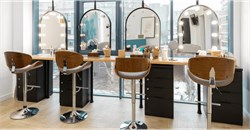Menu
The importance of a good consultation
Client consultations are not only a legal requirement before treatment, but also an opportunity to discover what your client wants, along with possible contraindications, and achieve the perfect end result. Even regular clients need a consultation as hair, nails and skin condition can change over time. Read on to learn how to get the most from each consultation.

Questions
Ask questions and listen carefully to ensure you understand the client’s desires and requirements. Use open questions that require more than a yes or no answer. Give the client confidence that you are dedicated to giving them a fantastic service and make recommendations accordingly. Repeat key information back to the client. For example, showing them how much hair you will cut. Before you start working on the client, always check they have no more questions.
Analyse
Check over the area you will be performing the treatment on, such as hair, skin or nails. Tailor your ideas to their specific desire, concern or problem. Discuss findings with the client and, again, make recommendations.
Keep a Record
Recording information about each of your clients allows you to build a deeper understanding of their needs. Record information from consultations. Should their regular hairdresser or therapist be away, someone else can read their record to familiarise themselves with the client. Allergies, conditions and sensitivities must be noted. Keeping records up to date also allows you to identify other treatments or retail products that clients may be interested in.
Inspiration
Have hair or beauty magazines and pictures of your work available for the client to look through. Also, direct them to Instagram and Pinterest for further inspiration on current looks and trends. This may help clients who lack confidence or are unsure about the look they want. Use the client’s language, not industry jargon they may not understand.
Building Relationships
Consultations offer hair and beauty professionals a chance to develop a rapport with clients. Be positive and friendly from the start, putting the client at ease. Be aware of your body language, sit at their level, smile and avoid folding your arms. Get to know your clients - Every client is different; some will have very strong views of what they want, others will be looking for inspiration and suggestions. Some may prefer a questionnaire, other may prefer only face-to-face questions. Read their records to remind yourself of key information and previous treatments before the client returns for their next appointment.
Confidentiality
Be aware that the client has trusted you with private, often sensitive, information. Store carefully and adhere to the Data Protection Act.
Meet Clients Expectations
Clients will be seeking expert advice from a professional they can trust. Give them tailored ideas and tips to suit their skin tone, hair colour, condition, face shape etc. Manage their expectations. Ask them questions about their job, hobbies and family life. Would a high maintenance hairstyle fit in with your client’s lifestyle? Read their body language. Are they saying yes but shrugging their shoulders or seeming non-committal? Politely check and double check what they want. Also, discuss after care and retail products.
Opportunities to Upsell
Don’t be afraid to suggest additional services or ancillary products to clients during the consultation.If they are in for a manicure, you could discuss gel polish or nail art. If they are in for a cut and re-style, you could discuss colour options. If they decide upon your upsell, make sure they are aware of and happy about the cost.
Retail
Establish what your client’s concerns or problems are with, for example, their hair, skin or nails. Suggest retail products they might like that could help with after care.
Complaints
If your client returns to you unhappy after the treatment, the consultation form can provide a handy paper trail for you to check what was discussed and agreed, as well as any existing allergies or conditions. Read our blog on How To Deal With Client Complaints.
Imagery sourced from Pinterest.
















